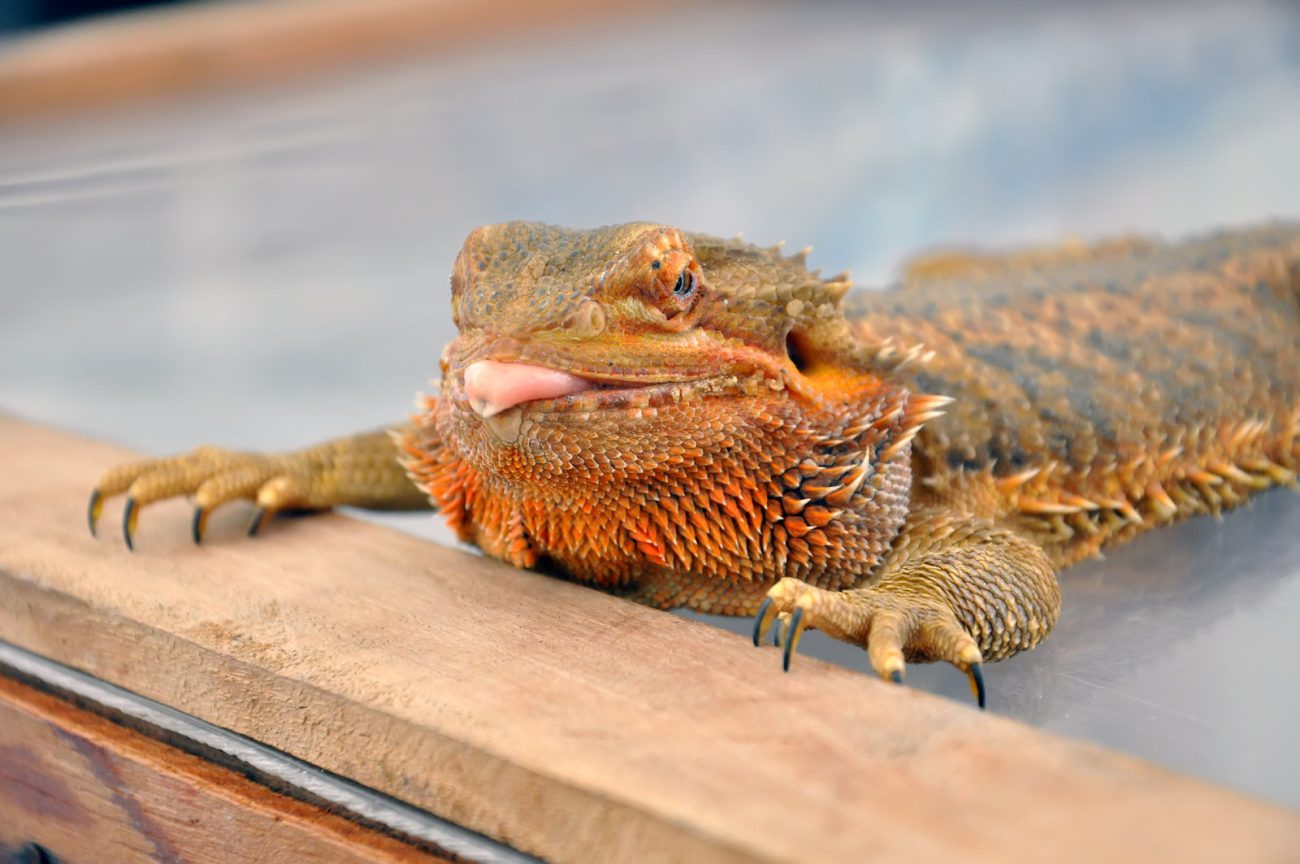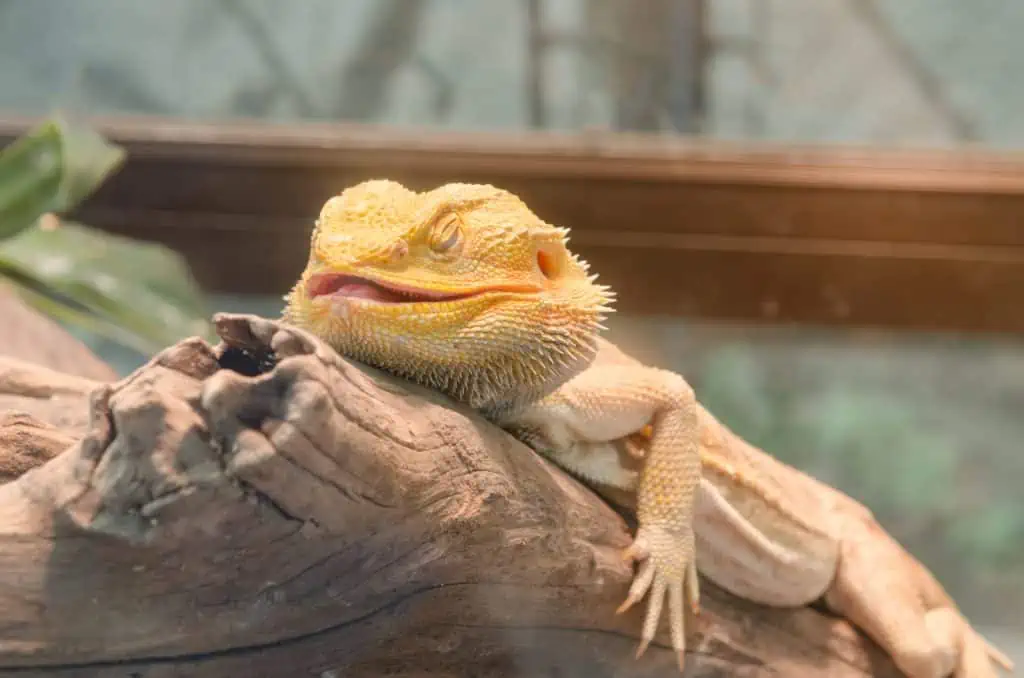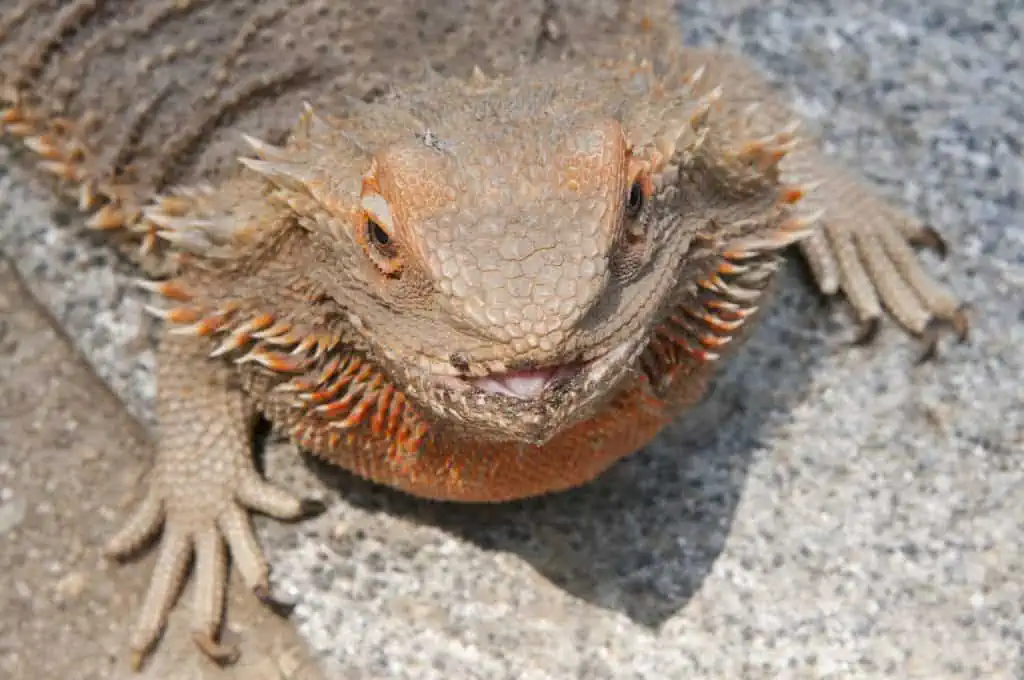Do you ever see your bearded dragon licking things? This behavior is quite common for these lizards. However, the reason for it’s often misunderstood. It is commonly believed that licking is a sign of fear, or that it is a sign of affection when your beardie licks you.
The truth of this behavior is more interesting than these claims. In this article, you’ll discover the science behind your beardie’s licking behavior. As you’ll see, bearded dragons are using a secret sense to gain information about their world.
What Do Bearded Dragons Use Their Tongue For?
Inside the roof of your beardie’s mouth is a special structure known as Jacobson’s organ. The Jacobson is a sensory organ used to process information from its environment. When your pet licks, it collects information for Jacobson’s organ to process.
After the information is processed, it’s sent to the brain, where it’s interpreted. This method for analyzing information is also used when snakes flick out their tongue.
Does Licking Help Them Smell?
Licking behavior helps bearded dragons smell. When the Jacobson organs process information received by the tongue, some of that information involves odors. It could be said that bearded dragons taste and smell with their tongue.
Reasons Your Bearded Dragon Is Licking
As stated earlier, licking is how bearded dragons gather information about their environment. Therefore, bearded dragons lick to gather information about different situations:
Changes in the Environment
When bearded dragons are put in a new environment, they will explore their surroundings by licking surfaces. Licking is one of the ways that they can get information about their new home. This same behavior can be seen if you make any major changes to your pet’s home.
The licking behavior of bearded dragons varies in frequency with age, with baby and juvenile bearded dragons licking with greater frequency than adults. The reason for this makes sense. Adult bearded dragons have experienced their environment for longer periods.
Hence, they are accustomed to it. For this reason, there is less of a need for licking. Baby and juvenile bearded dragons have had less exposure to their environment, so they will spend more time licking to learn about their environment.
Given this behavior, it’s important that you make your beardies home safe so that it does not lick anything that may be toxic. You can do that by:
Use only non-toxic décor.
Use only non-toxic chemicals to clean the enclosure.
Avoid toxic plants such as:
- Rosemary
- Arrowhead Vine
- Bluebonnet
- Cassava Root
- Daffodils
- Elderberry
- Mistletoe
- Poinsettia
- Sage
- Tulip
- Yucca
Plants that are safe to use include:
- Tillandsia Ionantha
- Hoya australis
- Callistemon
- Echeveria
- Beaucarnea recurvata
A Note About Substrate
For the safety of your bearded dragon, it’s important to consider licking behavior and the substrate you use. While licking behavior is common in bearded dragons, it occurs even more frequently in baby beardies.
Bearded dragons can get impactions, which is a blockage in their gut. This condition can be fatal if it’s not cleared. One of the ways that bearded dragons get impactions is through ingesting substrate.
There Are Three Reasons Why Beardies Ingest Substrate:
- They ingested it while licking.
- They ingested substrate unintentionally while eating.
- They eat the substrate intentionally because they are malnourished and want to supplement their body’s hunger for calcium.
To Avoid Blockages in Bearded Dragons, Do the Following:
- Ensure that your beardie is getting calcium supplements and UVB lighting.
- Avoid substrates that are small enough to be ingested, particularly for baby beardies. The best substrates to use are:
- Paper Towels
- Newspaper
- Reptile Carpet
- Tiles
- Vinyl Flooring
- ZooMed Excavator Clay
Breeding
During the mating season, male bearded dragons will seek out mates. To do this, they will stick out their tongue in the air to test for pheromones, a scent that females give off. By testing the air, they can tell if a female is within range.
Territory
Some believe that licking behavior may also be involved in marking territory. However, this does not make sense. How can territory be marked by licking it? A more plausible theory is that bearded dragons, being territorial, may use licking to detect the scent of other dragons.
Also, male and female bearded dragons seem to engage in increased licking behavior when members of the same sex are nearby.
Checking Out Temperature
Licking can also help bearded dragons determine the temperature of their surroundings. Being cold-blooded, the only way that bearded dragons can control their body temperature is to depend on their surrounding environment.
For this reason, they need to know the temperature of their surroundings. By licking different objects in their enclosure, they can tell if their temperature meets their needs.
It’s important to note that there is a difference between your bearded dragon sticking its tongue in the air and keeping its mouth open. Like other reptiles, beardies will keep their mouth open to thermoregulate. What this means is that they are trying to regulate their body temperature.
If they are too hot, bearded dragons keep their mouths open to release heat to cool their bodies. If your bearded dragon is demonstrating this behavior, check the temperature of its enclosure.
The enclosure should have a thermogradient, offering different temperatures at different locations. The hottest part of the enclosure should be between 92-110 degrees Fahrenheit. This should be where your lizard basks. The cooler part of the enclosure should be kept between 75-85 degrees Fahrenheit.
Dehydration
When dehydrated, bearded dragons will open their mouths and extend their tongues. Bearded dragons always need to have water available to them. If you suspect your bearded dragon is dehydrated, bathe your pet by putting it in shallow water for around 30 minutes. The water should be no higher than their shoulders. Also, keep an eye on them at all times.
Is Licking Aggressive Behavior?
Licking is not an aggressive behavior. If anything, it’s used to temper moods as it has a role in determining dominance. Bearded dragons will often lick each other before displaying dominant behaviors such as bobbing their head and displaying their beards.
Male bearded dragons lick more frequently than females. This is because male bearded dragons’ licking behavior is a way to establish dominance. Female bearded dragons engage in licking behavior to display submission toward other beardies.
Do Bearded Dragons Lick to Show Affection?
Bearded dragons and other reptiles do not experience emotions like cats and dogs do. Bearded dragons can recognize their owner, but licking is not a sign of affection. Such statements are made from an anthropomorphic perspective. The term “anthropomorphic” means attributing human thoughts and feelings to animals.
The challenge is that such statements cannot be proven. However, it may be true that a bearded dragon that finds comfort in being held is more likely to lick you. It appears licking behavior becomes more frequent when these lizards are calm.
Bearded dragons use their tongue to gain information about their environment. Their tongues are equipped with chemoreceptors that allow them to collect information about their environment. When bearded dragons lick you, they are collecting information about you.
Take Care!
We hope that you enjoyed this article. The more you understand the reasons behind your beardie’s behavior, the better you’ll be able to meet their needs. Understanding licking behavior will help you better understand their relationship with their enclosure, other beardies, and you. We welcome your comments, and please share.





4 Comments
I love reptile carpet, because it’s found in nature all the time. With nothing to aid in the cleaning and scraping of dead scales away from their bellies, glands, or their butts after they poop, you’re ganna have more problems than a constipated lizzard for sure.
Hi Sonia,
While I understand your perspective, reptile carpet is actually not a natural substrate and can be harmful to reptiles. It can trap bacteria and parasites due to its fibers, potentially leading to infections. Additionally, the fibers can snag a reptile’s scales, claws, or teeth, causing injuries.
For a healthier environment, consider natural substrates like a bioactive soil mixture, or non-adhesive shelf liner. These provide opportunities for natural behaviors that benefit your reptile. You can find more information on Best Substrate and Bedding For Bearded Dragons in this article on our website.
This was very helpful I stumbled across it on accident and have always wondered why my bearded still licks at things that have been with her in several different enclosures since I first brought her home, now I guess she just hasn’t fully grasped the concept of certain objects
Hi Donovan,
It’s quite fascinating how bearded dragons interact with their environment, isn’t it? The licking behavior you’ve observed in your bearded dragon is actually quite normal and is part of their way of exploring the world around them. They use their tongues to gather information about objects, even familiar ones, much like how we use our hands to feel things. It’s part of their instinct to understand their surroundings and a sign of their curiosity and health.
Take care and give your bearded friend a gentle pat from me!